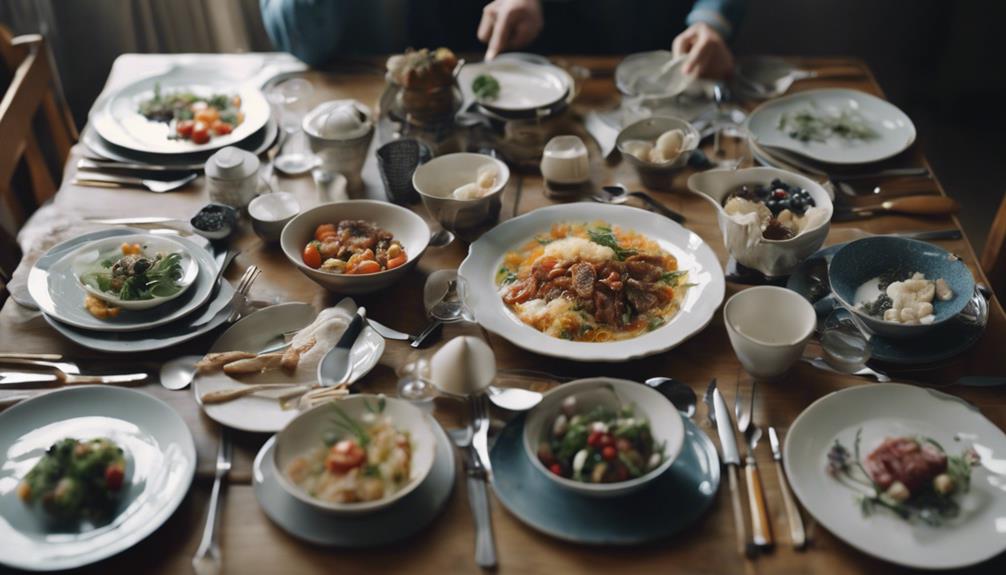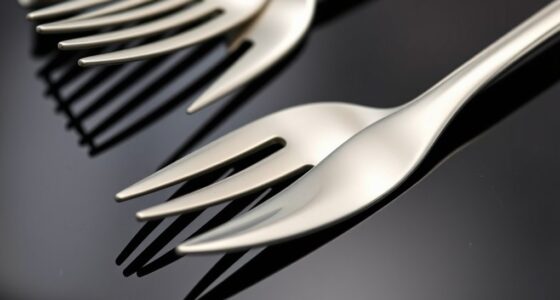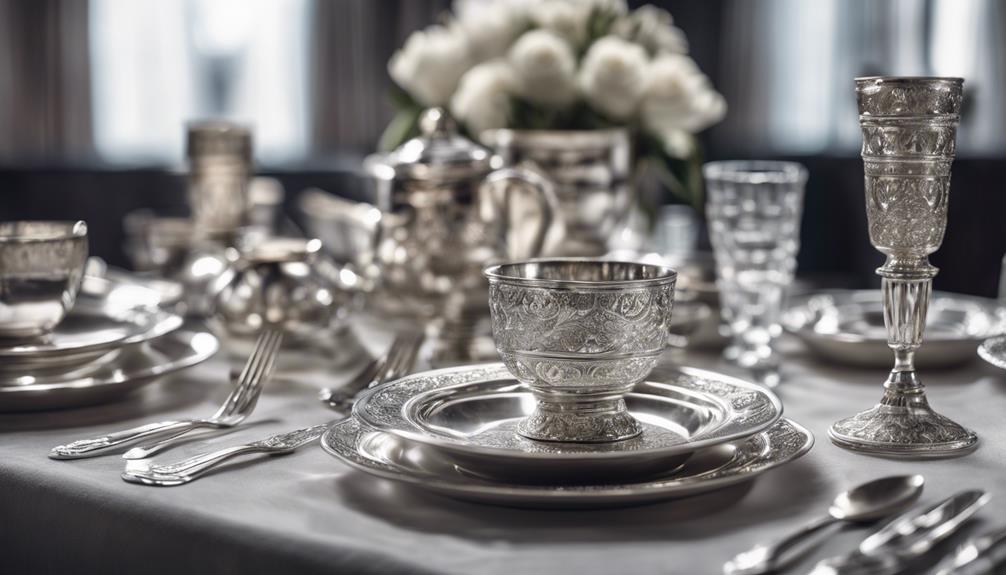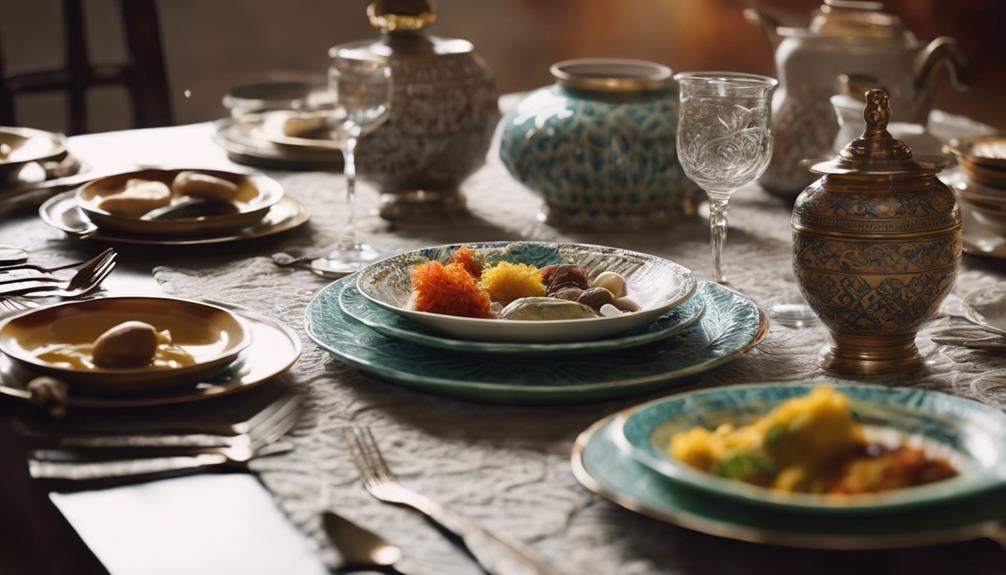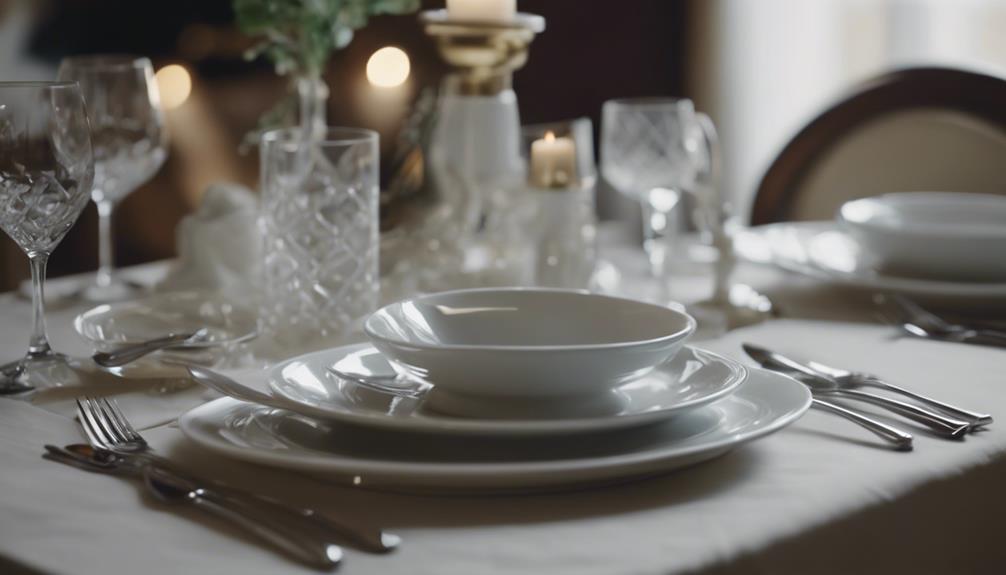Tableware encompasses the necessary collection of utensils and dishware for serving and enjoying meals. It consists of plates, bowls, silverware, and drinkware, all working together to enhance dining experiences worldwide. From simple pottery to elegant silver flatware, tableware has undergone transformations over the centuries. Cultural symbols and historical influences have played a role in shaping the wide variety of tableware items available today. Whether it’s a formal dinner or a casual gathering, having the right tableware ensures that meals are well-presented and enjoyable. Understanding the materials, styles, and cultural importance of tableware can bring a new level of richness to your dining experience. There is much to discover in terms of how tableware enhances culinary traditions and influences dining environments.
Key Takeaways
- Tableware refers to utensils, dishes, and accessories used for dining and serving food.
- It includes items like plates, cups, silverware, and serving platters for meal presentation.
- Tableware encompasses a wide range of materials, designs, and cultural influences.
- Symbolizes cultural traditions, social status, and plays a role in dining experiences.
- Tableware selection impacts the visual appeal and practicality of dining occasions.
Origin and Evolution of Tableware
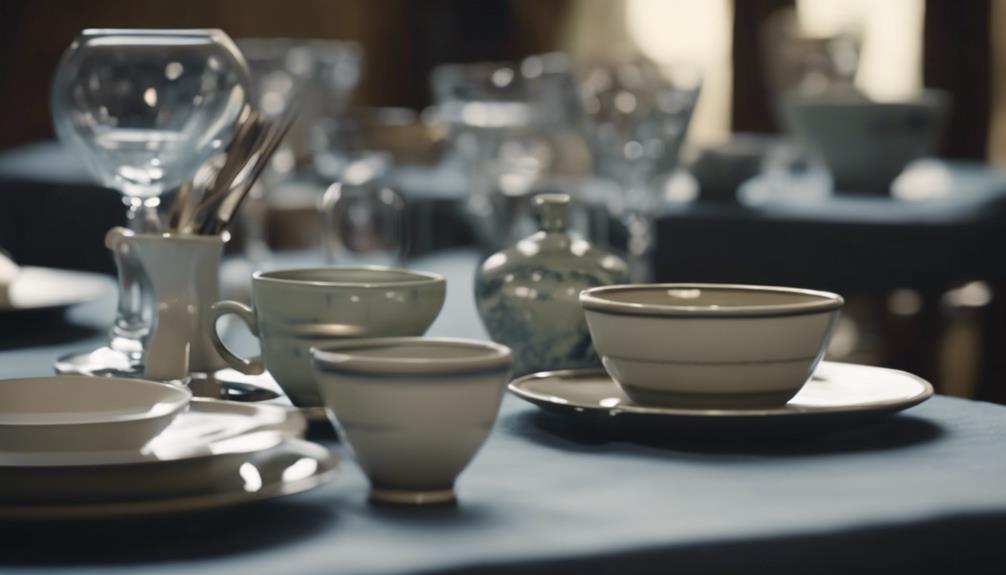
Tableware has transformed greatly throughout history, evolving from basic pottery to luxurious silver and gold flatware favored by ancient elites. In medieval times, plates as they're recognized today weren't common. Instead, trenchers, which were bread rounds used as plates, were popular for serving food. These early makeshift plates were a precursor to the specialized tableware we use currently. The ownership of such tableware was once a symbol of wealth, with sumptuary laws in place to control extravagance.
Interestingly, plate melting for financial gain during the Middle Ages resulted in limited surviving examples of historic tableware. This makes the existing examples even more precious, providing valuable insights into the craftsmanship and styles of the past. The term 'tableware' encompasses a wide range of items used for dining, each reflecting cultural norms and historical influences. Plates, in particular, have come a long way from humble beginnings to the diverse array of options available today.
Different Types of Tableware
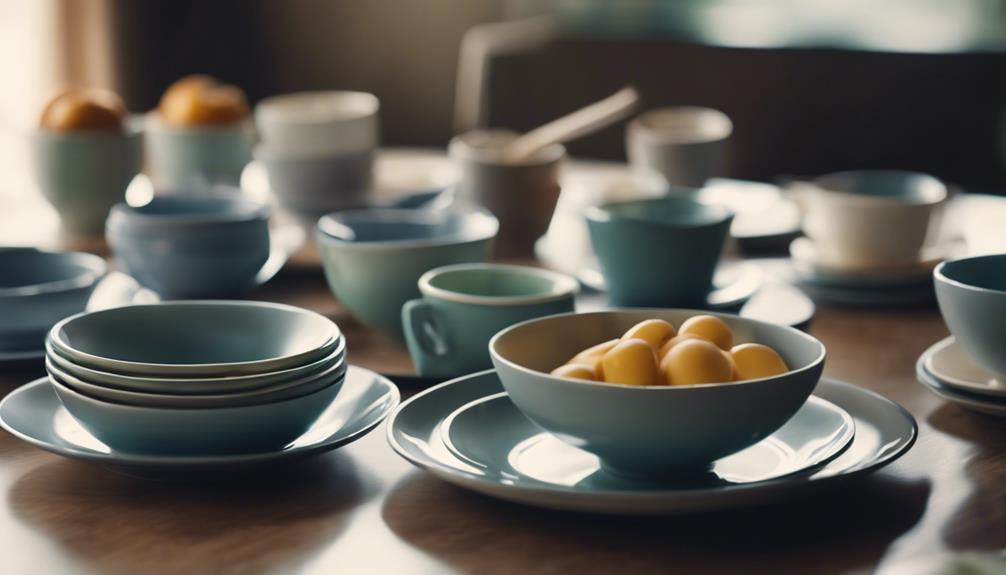
As tableware evolved over time, it diversified into various types, each serving distinct purposes in dining experiences. Serve ware, like serving platters and teapots, are essential for presenting and serving food elegantly.
Dinnerware, including plates and bowls, caters to individual place settings, providing the vessels for enjoying meals. Silverware and cutlery, such as knives, forks, and spoons, come in various materials and designs for different dining needs.
Drinkware plays an important role in the dining experience, with cups, glasses, and stemware tailored for serving beverages like coffee, wine, and cocktails. Each type of tableware contributes to the overall dining experience by holding food, serving drinks, and enhancing the visual appeal of the table setting.
Whether it's a formal dinner party or a casual gathering, having the right tableware ensures that every aspect of the meal is well presented and enjoyable.
Materials Used in Tableware
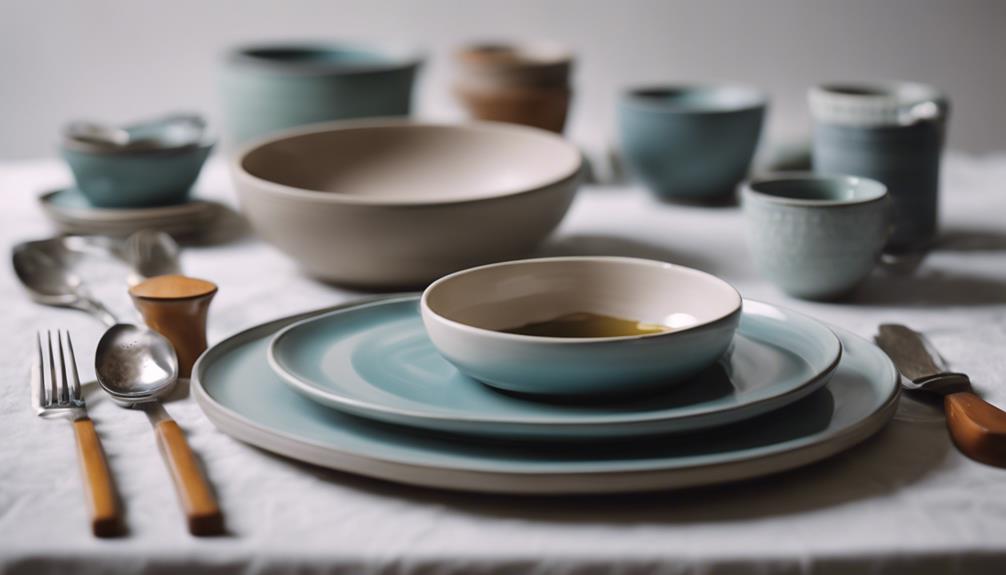
Tableware materials like ceramic, glass, stainless steel, silver, and wood offer a variety of options for your dining needs. Each material has its own unique characteristics, from durability to aesthetics.
Understanding the differences between these materials can help you choose the best tableware for your style and practical considerations.
Common Tableware Materials
When selecting tableware materials, consider the common options like ceramic, glass, stainless steel, silver, and wood. Ceramic tableware, which includes earthenware, stoneware, bone china, and porcelain, offers a wide range of styles and designs suitable for various occasions.
Stainless steel is a durable and practical choice, often used for cutlery in tableware sets due to its resistance to rust and staining. Glass is commonly used for drinkware such as cups, glasses, and stemware, adding an elegant touch to table settings.
Wood, while less common, can bring a rustic or decorative element to the tableware collection. Each material brings its own unique characteristics and aesthetics to enhance your dining experience.
Sustainable Tableware Options
Consider opting for sustainable tableware options made from materials like bamboo, palm leaf, sugarcane bagasse, and cornstarch to reduce the environmental impact of traditional disposable tableware. These biodegradable materials offer eco-friendly alternatives that are both practical and stylish.
Here are some benefits of choosing these sustainable options:
- Bamboo Tableware: Durable, lightweight, and naturally antimicrobial.
- Palm Leaf Tableware: Unique and elegant look, compostable, and biodegradable.
- Sugarcane Bagasse and Cornstarch Tableware: Compostable alternatives to plastic, suitable for plates, cups, and utensils.
Traditional Vs. Modern Designs
Traditional tableware designs embody a sense of timeless elegance through the use of materials such as ceramic, glass, and silver. These materials have been favored for their classic appeal and sophistication.
In contrast, modern tableware designs opt for materials like stainless steel, wood, and innovative sustainable options to achieve a contemporary aesthetic. Ceramic has a rich history in traditional tableware, while stainless steel is a popular choice in modern designs due to its durability and sleek appearance.
The shift from traditional to modern tableware reflects a focus on functionality and eco-friendliness, catering to diverse dining preferences and sustainability concerns. Whether you prefer the classic charm of ceramic or the modern edge of stainless steel, both traditional and modern designs offer unique styles to suit various tastes.
Cultural Significance of Tableware
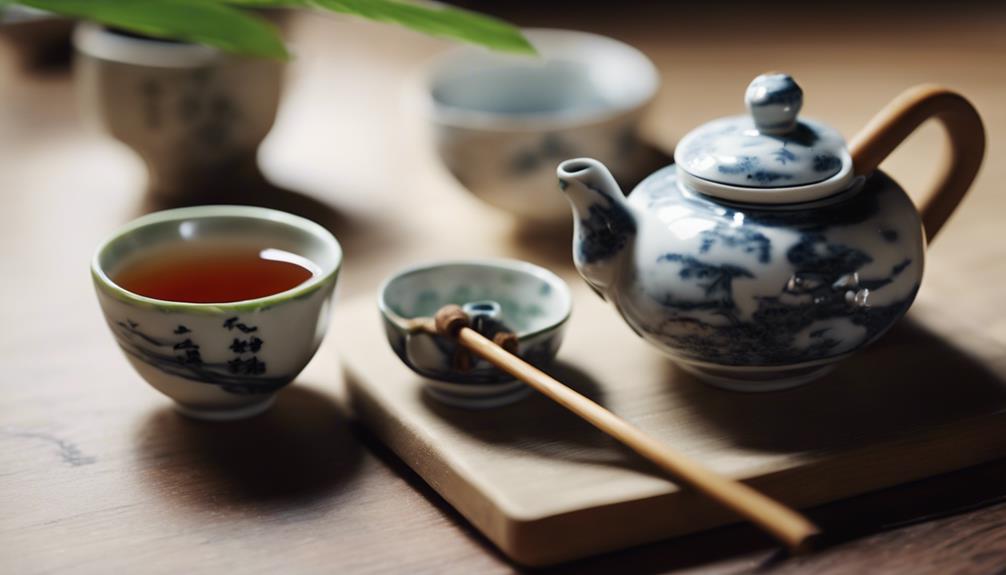
Tableware holds significant cultural value, reflecting traditions and symbolism in various societies. Rituals surrounding table settings and dining customs are often intertwined with the use of specific tableware items.
Exploring the cultural significance of tableware reveals a deeper connection to history and societal norms.
Symbolism in Tableware
Symbolism in tableware, deeply rooted in history, reveals intricate tales of wealth, power, and societal hierarchies. Different materials and designs were used to convey specific messages about the owner's status and cultural values. Here are some key points to ponder:
- Materials Used: Precious metals like gold and silver were commonly employed in tableware to showcase affluence and power.
- Design Significance: Intricate patterns and designs were often symbolic, representing cultural norms and beliefs.
- Sumptuary Laws: Regulations were in place to control who could use specific types of tableware based on their social standing, reinforcing hierarchies and distinctions within society.
These elements highlight how tableware served as more than just functional objects, but as symbols of status and cultural identity.
Rituals and Traditions
As you explore the cultural significance of tableware, you uncover a tapestry of rituals and traditions woven into the fabric of communities worldwide. Tableware holds immense importance in various cultural ceremonies and social gatherings, adding layers of meaning and symbolism to these events. Ceremonial plates and utensils play a vital role in signifying respect, honor, and tradition within different cultural contexts. These items are not merely tools for serving food but are carriers of historical significance, preserving heritage and connecting generations through shared dining practices. The specific use of tableware items like ceremonial plates and utensils enhances the overall experience of rituals, family gatherings, and social events, reflecting the values and customs deeply rooted in each community.
| Ceremonial Plates | Utensils |
|---|---|
| Symbolize respect, honor, and tradition | Serve practical and symbolic roles |
| Enhance the experience of cultural ceremonies | Carry historical significance |
| Connect generations through shared dining practices | Reflect values and customs of communities |
| Integral part of religious and social events | Preserve heritage and traditions |
Tableware in Various Culinary Traditions
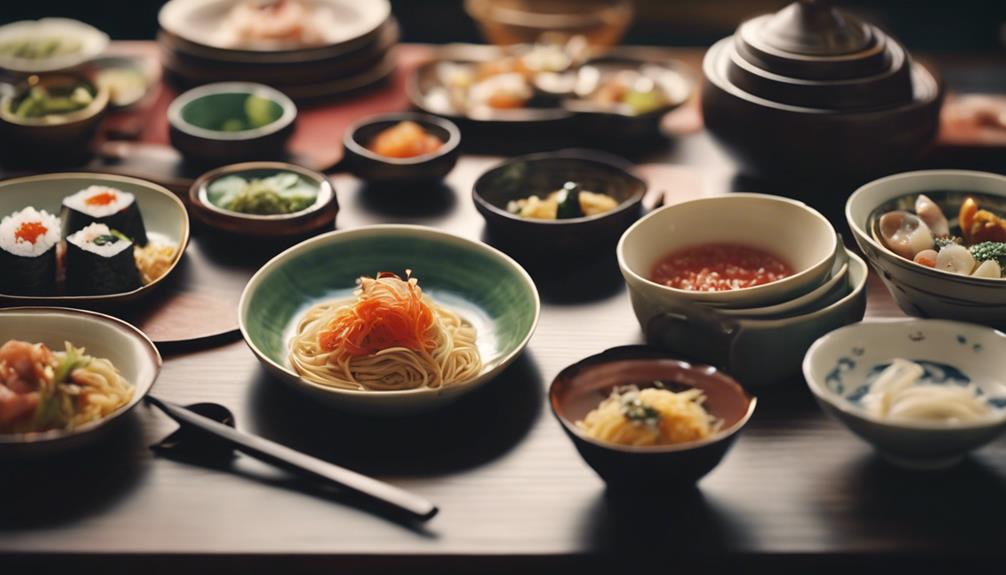
Across different culinary traditions, you'll find a diverse array of tableware, each reflecting the unique aesthetics and cultural influences of the respective cuisine.
- In Japanese cuisine, precision and attention to detail are evident in tableware such as sushi plates and sake sets, showcasing the artistry of the culture.
- Indian tableware often includes stainless steel thalis, perfect for serving multiple dishes in a single platter, emphasizing the communal aspect of dining.
- Chinese tableware features delicate tea sets, rice bowls, and chopsticks, symbolizing the rich cultural heritage and traditions of the country.
Each culinary tradition's tableware not only serves a practical function but also adds a touch of authenticity and tradition to the dining experience. Whether it's the elegant porcelain dinner plates in French cuisine or the intricate tea sets in Chinese culture, tableware plays a significant role in enhancing the overall dining ambiance and enjoyment of the meal.
Tableware Vs. Flatware: Understanding the Difference
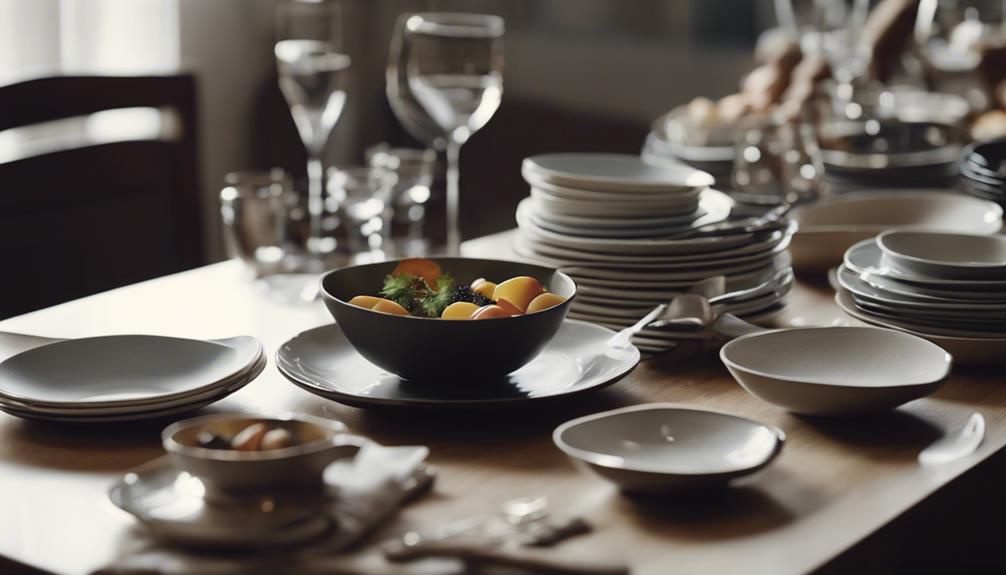
Let's explore the distinction between tableware and flatware to understand their roles in setting a table and enhancing the dining experience. Tableware encompasses a wider range of items used for table setting, including dishes, glassware, and utensils. On the other hand, flatware specifically refers to the utensils like knives, forks, and spoons used for eating. To better grasp the difference, take a look at the table below:
| Tableware | Flatware |
|---|---|
| Plates | Knives |
| Bowls | Forks |
| Cups | Spoons |
| Glassware | |
| Serving dishes |
Understanding these differences is important for a proper table setting. While flatware is essential for eating, tableware includes a broader range of items that contribute to the overall dining experience. Next, let's explore tips for selecting the right tableware for events.
Tableware Selection Tips for Events

When selecting tableware for events, consider the nature of the occasion and the number of guests attending to guarantee a well-prepared dining experience. Here are some tips to help you make the right choices:
- Nature of the Event: Determine if it's a formal dinner, casual gathering, or buffet-style event to select the appropriate tableware for the occasion.
- Number of Guests: Make sure you have enough tableware for all guests attending the event. Consider having extra pieces for unexpected guests or accidents.
- Menu and Courses: Match the tableware to the type of food being served. Different tableware includes plates, bowls, glasses, and serving platters for various dishes.
The Impact of Tableware on Dining Experience
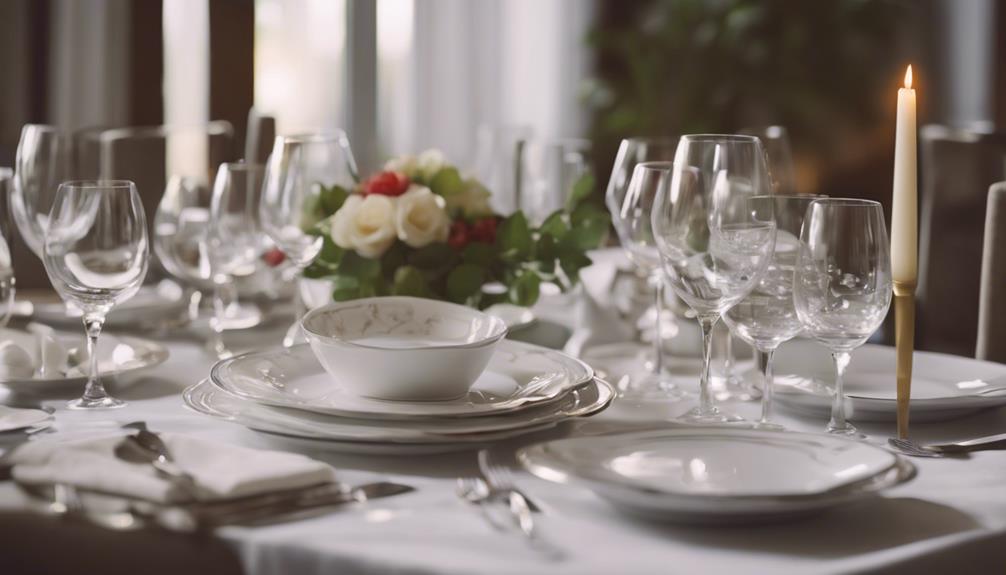
Choosing the appropriate tableware can greatly enhance the overall dining experience by adding aesthetic value and reflecting cultural norms. The type of tableware used, such as elegant soup bowls or modern kitchen utensils, can have a substantial impact on how you perceive and enjoy your meal. The presentation of food on well-selected tableware not only enhances the visual appeal but also sets the tone for the dining experience. Different materials like ceramic, glass, stainless steel, silver, and wood offer varying textures and styles that can elevate your mealtime ambiance.
Moreover, tableware serves practical functions beyond aesthetics. The design and quality of tableware affect how comfortably you hold, serve, and enjoy your food. For instance, using the right soup bowls can enhance the taste of your favorite soups, while well-designed kitchen utensils can make cooking and dining more efficient and enjoyable. By considering the impact of tableware on your dining experience, you can create a more pleasant and culturally reflective atmosphere for yourself and your guests.
Frequently Asked Questions
What Is the Meaning of Tableware?
Tableware is the collective term for dishes, utensils, and serving pieces used for dining. It includes items like plates, bowls, cutlery, glasses, and serving platters. Tableware serves functional purposes in holding, serving, and handling food during meals.
The term also covers accessories like napkin rings, salt and pepper shakers, and butter dishes. It plays a significant role in enhancing the dining experience and reflecting cultural norms.
What Is the Definition of Tableware in Cooking?
Tableware in cooking refers to essential items like plates, bowls, utensils, and glassware used for serving and enjoying food. It encompasses a variety of products including dinnerware, flatware, drinkware, and serving dishes.
These items are vital in enhancing your dining experience by adding both aesthetic value and functionality to your meals. Different materials like ceramic, glass, stainless steel, and wood are commonly used to create tableware that complements your dining setting.
What Items Are Tableware?
Tableware items like plates, bowls, cups, and serving platters are essential for dining. They come in various materials such as ceramic, glass, stainless steel, and wood to suit different needs and styles.
Your choice of tableware depends on the event, dining setting, number of guests, menu, and personal preferences. Make sure you have dinner plates, soup bowls, salad plates, teapots, and utensils to create a complete dining experience.
What Is Tableware and Its Four Types?
When it comes to tableware and its four types, here's the breakdown for you:
Hollowware includes serving essentials like bowls and platters.
Flatware covers utensils such as forks, knives, and spoons.
Cutlery specifically deals with knives and cutting tools used during meals.
Understanding these categories helps you set a complete table for any occasion, from everyday dining to special gatherings.
Conclusion
To sum up, tableware encompasses a wide range of items used for dining, from plates and glasses to serving dishes and utensils. The variety of materials, styles, and cultural influences make tableware an essential part of any dining experience.
Choosing the right tableware can enhance the visual appeal of a meal and elevate the overall dining experience. It's not just about functionality, but also about creating a visually pleasing and memorable setting for enjoying food with friends and family.
